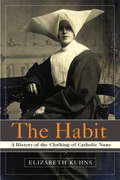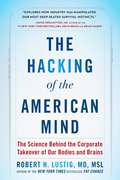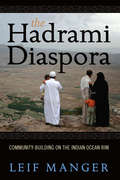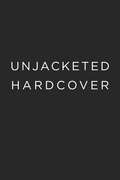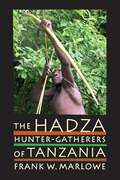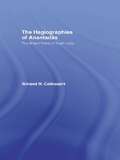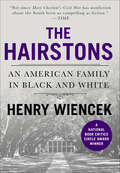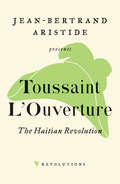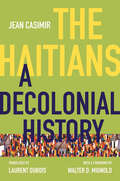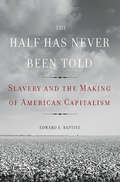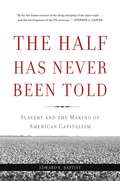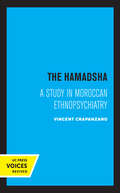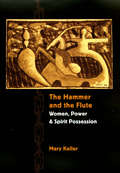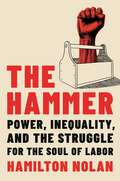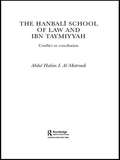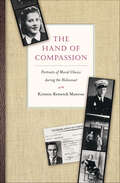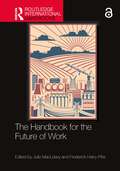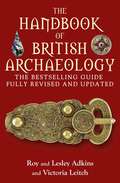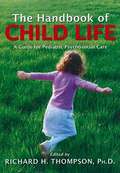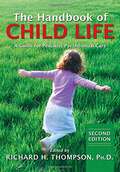- Table View
- List View
The Habit: A History of the Clothing of Catholic Nuns
by Elizabeth KuhnsCuriosity about nuns and their distinctive clothing is almost as old as Catholicism itself. The habit intrigues the religious and the nonreligious alike, from medieval maidens to contemporary schoolboys, to feminists and other social critics. The first book to explore the symbolism of this attire, The Habit presents a visual gallery of the diverse forms of religious clothing and explains the principles and traditions that inspired them. More than just an eye-opening study of the symbolic significance of starched wimples, dark dresses, and flowing veils, The Habit is an incisive, engaging portrait of the roles nuns have and do play in the Catholic Church and in ministering to the needs of society.From the clothing seen in an eleventh-century monastery to the garb worn by nuns on picket lines during the 1960s, habits have always been designed to convey a specific image or ideal. The habits of the Benedictines and the Dominicans, for example, were specifically created to distinguish women who consecrated their lives to God; other habits reflected the sisters' desire to blend in among the people they served. The brown Carmelite habit was rarely seen outside the monastery wall, while the Flying Nun turned the white winged cornette of the Daughters of Charity into a universally recognized icon. And when many religious abandoned habits in the 1960s and '70s, it stirred a debate that continues today.Drawing on archival research and personal interviews with nuns all over the United States, Elizabeth Kuhns examines some of the gender and identity issues behind the controversy and brings to light the paradoxes the habit represents. For some, it epitomizes oppression and obsolescence; for others, it embodies the ultimate beauty and dignity of the vocation.Complete with extraordinary photographs, including images of the nineteenth century nuns' silk bonnets to the simple gray dresses of the Sisters of Social Service, this evocative narrative explores the timeless symbolism of the habit and traces its evolution as a visual reflection of the changes in society.From the Hardcover edition.
The Hacking of the American Mind: The Science Behind the Corporate Takeover of Our Bodies and Brains
by Robert H. Lustig"Explores how industry has manipulated our most deep-seated survival instincts."—David Perlmutter, MD, Author, #1 New York Times bestseller, Grain Brain and Brain MakerThe New York Times–bestselling author of Fat Chance reveals the corporate scheme to sell pleasure, driving the international epidemic of addiction, depression, and chronic disease. While researching the toxic and addictive properties of sugar for his New York Times bestseller Fat Chance, Robert Lustig made an alarming discovery—our pursuit of happiness is being subverted by a culture of addiction and depression from which we may never recover. Dopamine is the “reward” neurotransmitter that tells our brains we want more; yet every substance or behavior that releases dopamine in the extreme leads to addiction. Serotonin is the “contentment” neurotransmitter that tells our brains we don’t need any more; yet its deficiency leads to depression. Ideally, both are in optimal supply. Yet dopamine evolved to overwhelm serotonin—because our ancestors were more likely to survive if they were constantly motivated—with the result that constant desire can chemically destroy our ability to feel happiness, while sending us down the slippery slope to addiction. In the last forty years, government legislation and subsidies have promoted ever-available temptation (sugar, drugs, social media, porn) combined with constant stress (work, home, money, Internet), with the end result of an unprecedented epidemic of addiction, anxiety, depression, and chronic disease. And with the advent of neuromarketing, corporate America has successfully imprisoned us in an endless loop of desire and consumption from which there is no obvious escape. With his customary wit and incisiveness, Lustig not only reveals the science that drives these states of mind, he points his finger directly at the corporations that helped create this mess, and the government actors who facilitated it, and he offers solutions we can all use in the pursuit of happiness, even in the face of overwhelming opposition. Always fearless and provocative, Lustig marshals a call to action, with seminal implications for our health, our well-being, and our culture.
The Hadrami Diaspora: Community-Building on the Indian Ocean Rim
by Leif MangerThe Hadramis of South Yemen and the emergence of their diasporic communities throughout the Indian Ocean region are an intriguing facet of the history of this region’s migratory patterns. In the early centuries of migration, the Yemeni, or Hadrami, traveler was both a trader and a religious missionary, making the migrant community both a “trade diaspora” and a “religious diaspora.” This tradition has continued as Hadramis around the world have been linked to networks of extremist, Islamic-inspired movements—Osama bin Laden, leader of Al Qaeda and descendant of a prominent Hadrami family, as the most infamous example. However, communities of Hadramis living outside Yemen are not homogenous. The author expertly elucidates the complexity of the diasporic process, showing how it contrasts with the conventional understanding of the Hadrami diaspora as an unchanging society with predefined cultural characteristics originating in the homeland. Exploring ethnic, social, and religious aspects, the author offers a deepened understanding of links between Yemen and Indian Ocean regions (including India, Southeast Asia, and the Horn of Africa) and the emerging international community of Muslims.
The Hadza: Hunter-Gatherers of Tanzania
by Frank W. MarloweThe Hadza, who inhabit an area of East Africa near the Serengeti and Olduvai Gorge, have long drawn the attention of anthropologists and archaeologists for maintaining a foraging lifestyle in a region that is key to understanding human origins.
The Hadza: Hunter-Gatherers of Tanzania (Origins of Human Behavior and Culture #3)
by Frank MarloweIn The Hadza, Frank Marlowe provides a quantitative ethnography of one of the last remaining societies of hunter-gatherers in the world. The Hadza, who inhabit an area of East Africa near the Serengeti and Olduvai Gorge, have long drawn the attention of anthropologists and archaeologists for maintaining a foraging lifestyle in a region that is key to understanding human origins. Marlowe ably applies his years of research with the Hadza to cover the traditional topics in ethnography—subsistence, material culture, religion, and social structure. But the book’s unique contribution is to introduce readers to the more contemporary field of behavioral ecology, which attempts to understand human behavior from an evolutionary perspective. To that end, The Hadza also articulates the necessary background for readers whose exposure to human evolutionary theory is minimal.
The Hagiographies of Anantadas: The Bhakti Poets of North India
by Winnand CallewaertAnantadas is the first 'biographer' who, around 1600, wrote about the most popular bhakti poets of the 15th and 16th centuries in Northern India. This critical study of these manuscripts yields a broad spectrum of the linguistic and morphological variants. It also reveals the processes of oral and scribal transmission during this time when sectarian interests appropriated certain poets and changed their 'biographies' accordingly.
The Hairstons: An American Family in Black and White
by Henry WiencekThis “lovingly detailed history” chronicles the largest slaveholding family in the Old South, as its descendants—white and Black—grapple with its legacy (The Dallas Morning News).A National Book Critics Circle Award WinnerSpanning two centuries of one family’s history, The Hairstons tells the extraordinary story of the Hairston clan, once the wealthiest family in the Old South and the largest slaveholder in America. With several thousand black and white members, the Hairstons of today share a complex and compelling history: divided in the time of slavery, they have come to embrace their past as one family.For seven years, journalist Henry Wiencek combed the far-reaching branches of the Hairston family tree to piece together the experiences of both plantation owners and their slaves. Crisscrossing the old plantation country of Virginia, North Carolina, and Mississippi, The Hairstons reconstructs the triumphant rise of the remarkable children, grandchildren, and great-grandchildren of the enslaved as they fought to take their rightful place in mainstream America. It also follows the white descendants through the decline and fall of the Old South, and uncovers the hidden history of slavery’s curse—and how that curse followed slaveholders for generations.
The Haitian Revolution
by Toussaint L'OuvertureToussaint L’Ouverture was the leader of the Haitian Revolution in the late eighteenth century, in which slaves rebelled against their masters and established the first black republic. In this collection of his writings and speeches, former Haitian politician Jean-Bertrand Aristide demonstrates L’Ouverture's profound contribution to the struggle for equality.
The Haitians: A Decolonial History (Latin America in Translation/en Traducción/em Tradução)
by Jean CasimirIn this sweeping history, leading Haitian intellectual Jean Casimir argues that the story of Haiti should not begin with the usual image of Saint-Domingue as the richest colony of the eighteenth century. Rather, it begins with a reconstruction of how individuals from Africa, in the midst of the golden age of imperialism, created a sovereign society based on political imagination and a radical rejection of the colonial order, persisting even through the U.S. occupation in 1915.The Haitians also critically retheorizes the very nature of slavery, colonialism, and sovereignty. Here, Casimir centers the perspectives of Haiti's moun andeyo—the largely African-descended rural peasantry. Asking how these systematically marginalized and silenced people survived in the face of almost complete political disenfranchisement, Casimir identifies what he calls a counter-plantation system. Derived from Caribbean political and cultural practices, the counter-plantation encompassed consistent reliance on small-scale landholding. Casimir shows how lakou, small plots of land often inhabited by generations of the same family, were and continue to be sites of resistance even in the face of structural disadvantages originating in colonial times, some of which continue to be maintained by the Haitian government with support from outside powers.
The Hakkas of Sarawak
by Kee Howe YongThis book tells the story of the Hakka Chinese in Sarawak, Malaysia, who were targeted as communists or communist sympathizers because of their Chinese ethnicity the 1960s and 1970s. Thousands of these rural Hakkas were relocated into "new villages" surrounded by barbed wire or detained at correction centres, where incarcerated people were understood to be "sacrificial gifts" to the war on communism and to the rule of Malaysia's judicial-administrative regime.The Hakkas of Sarawak looks at how these incarcerated people struggled for survival and dealt with their defeat over the course of a generation. Using methodologies of narrative theory and exchange theory, Kee Howe Yong provides a powerful account of the ongoing legacies of Cold War oppression and its impact on the lives of people who were victimized by these policies.
The Half Has Never Been Told
by Edward E. BaptistAmericans tend to assume that modern historiography has produced a full and complete understanding of slavery in the United States, as a shameful pre-modern institution, existing in isolation from America’s later success. But while we have long since rejected the idealistic depiction of happy slaves and paternalistic masters, we have not yet begun to grapple with the full extent of slavery’s horrors#151;or its link to the expansion of the country, the political battles that caused the Civil War, or the growth of our modern capitalist economy. . As historian Edward Baptist reveals in The Half Has Never Been Told, slavery and its expansion were central to the evolution and modernization of our nation in the 18th and 19th centuries, catapulting the US into a modern, industrial and capitalist economy. In the span of a single lifetime, the South grew from a narrow coastal strip of worn-out tobacco plantations to a sub-continental cotton empire. By 1861 it had five times as many slaves as it had during the Revolution, and was producing two billion pounds of cotton a year. It was through slavery and slavery alone that the United States achieved a virtual monopoly on the production of cotton, the key raw material of the Industrial Revolution, and was transformed into a global power rivaled only by England. The Half Has Never Been Told begins in 1787, when Northern emancipation and falling profits from Southern tobacco threatened the future of American slavery. Seeking desperately to prevent this collapse, innovative Southern enslavers brought slavery out of the Southeast’s decaying coastal plantation belts, leading trains of men, women, and children to the frontier states where the labor-intensive cotton crop beckoned. By 1860, their empire of cotton and labor camps stretched all the way to Texas. During America’s formative years, Baptist explains, our chief form of innovation was slavery, and ways to make slavery increasingly profitable. Through forced migration, quotas, and torture, slave owners extracted continual increases in efficiency from their slaves making competition with American cotton fields near impossible. Financial innovations and banks, meanwhile, helped feed credit to the cotton plantations, spurring on economic expansion and confirming for enslavers and their political leaders that their livelihood, and the American economy, depended on cotton. Despite the mayhem wreaked upon them, enslaved African-Americans survived, clinging desperately to the ability to name the evil they confronted. By the time of Abraham Lincoln’s election, the stories they smuggled out of the whipping-machine had helped to put the North and South on the collision course that led to the Civil War, national emancipation, and the collapse of the Southern slave industry#151;a system that, Baptist suggests, might otherwise have gone on indefinitely. Using thousands of interviews with former slaves, hundreds of plantation records, newspapers, and the personal papers of dozens of politicians, entrepreneurs, and escaped slaves, The Half Has Never Been Told unveils, at last, the most savage secrets at the heart of American history. These intimate stories of survival and tragedy transform our understanding of the rise of the American nation, the outbreak of the Civil War, and the birth of entrepreneurial capitalism. A much-needed challenge to the reigning narratives of slavery, The Half Has Never Been Told reveals the alarming extent to which our country’s success was irrevocably tied to the institution of slavery.
The Half Has Never Been Told
by Edward E. BaptistAmericans tend to assume that modern historiography has produced a full and complete understanding of slavery in the United States, as a shameful pre-modern institution, existing in isolation from America’s later success. But while we have long since rejected the idealistic depiction of happy slaves and paternalistic masters, we have not yet begun to grapple with the full extent of slavery’s horrors--or its link to the expansion of the country, the political battles that caused the Civil War, or the growth of our modern capitalist economy. . As historian Edward Baptist reveals in The Half Has Never Been Told, slavery and its expansion were central to the evolution and modernization of our nation in the 18th and 19th centuries, catapulting the US into a modern, industrial and capitalist economy. In the span of a single lifetime, the South grew from a narrow coastal strip of worn-out tobacco plantations to a sub-continental cotton empire. By 1861 it had five times as many slaves as it had during the Revolution, and was producing two billion pounds of cotton a year. It was through slavery and slavery alone that the United States achieved a virtual monopoly on the production of cotton, the key raw material of the Industrial Revolution, and was transformed into a global power rivaled only by England. The Half Has Never Been Told begins in 1787, when Northern emancipation and falling profits from Southern tobacco threatened the future of American slavery. Seeking desperately to prevent this collapse, innovative Southern enslavers brought slavery out of the Southeast’s decaying coastal plantation belts, leading trains of men, women, and children to the frontier states where the labor-intensive cotton crop beckoned. By 1860, their empire of cotton and labor camps stretched all the way to Texas. During America’s formative years, Baptist explains, our chief form of innovation was slavery, and ways to make slavery increasingly profitable. Through forced migration, quotas, and torture, slave owners extracted continual increases in efficiency from their slaves making competition with American cotton fields near impossible. Financial innovations and banks, meanwhile, helped feed credit to the cotton plantations, spurring on economic expansion and confirming for enslavers and their political leaders that their livelihood, and the American economy, depended on cotton. Despite the mayhem wreaked upon them, enslaved African-Americans survived, clinging desperately to the ability to name the evil they confronted. By the time of Abraham Lincoln’s election, the stories they smuggled out of the whipping-machine had helped to put the North and South on the collision course that led to the Civil War, national emancipation, and the collapse of the Southern slave industry--a system that, Baptist suggests, might otherwise have gone on indefinitely. Using thousands of interviews with former slaves, hundreds of plantation records, newspapers, and the personal papers of dozens of politicians, entrepreneurs, and escaped slaves, The Half Has Never Been Told unveils, at last, the most savage secrets at the heart of American history. These intimate stories of survival and tragedy transform our understanding of the rise of the American nation, the outbreak of the Civil War, and the birth of entrepreneurial capitalism. A much-needed challenge to the reigning narratives of slavery, The Half Has Never Been Told reveals the alarming extent to which our country’s success was irrevocably tied to the institution of slavery.
The Half Has Never Been Told: Slavery and the Making of American Capitalism
by Edward E. BaptistAmericans tend to cast slavery as a pre-modern institution-the nation's original sin, perhaps, but isolated in time and divorced from America's later success. But to do so robs the millions who suffered in bondage of their full legacy.As historian Edward Baptist reveals in The Half Has Never Been Told, the expansion of slavery in the first eight decades after American independence drove the evolution and modernization of the United States. In the span of a single lifetime, the South grew from a narrow coastal strip of worn-out tobacco plantations to a continental cotton empire, and the United States grew into a modern, industrial, and capitalist economy. Until the Civil War, Baptist explains, the most important American economic innovations were ways to make slavery ever more profitable. Through forced migration and torture, slave owners extracted continual increases in efficiency from enslaved African Americans. Thus the United States seized control of the world market for cotton, the key raw material of the Industrial Revolution, and became a wealthy nation with global influence.Told through intimate slave narratives, plantation records, newspapers, and the words of politicians, entrepreneurs, and escaped slaves, The Half Has Never Been Told offers a radical new interpretation of American history. It forces readers to reckon with the violence at the root of American supremacy, but also with the survival and resistance that brought about slavery's end-and created a culture that sustains America's deepest dreams of freedom.
The Hamadsha: A Study in Moroccan Ethnopsychiatry
by Vincent CrapanzanoThis title is part of UC Press's Voices Revived program, which commemorates University of California Press’s mission to seek out and cultivate the brightest minds and give them voice, reach, and impact. Drawing on a backlist dating to 1893, Voices Revived makes high-quality, peer-reviewed scholarship accessible once again using print-on-demand technology. This title was originally published in 1973.
The Hammer and the Flute: Women, Power, and Spirit Possession
by Mary KellerAward for the Best First Book in the History of Religions from the American Academy of ReligionFeminist theory and postcolonial theory share an interest in developing theoretical frameworks for describing and evaluating subjectivity comparatively, especially with regard to non-autonomous models of agency. As a historian of religions, Mary Keller uses the figure of the "possessed woman" to analyze a subject that is spoken-through rather than speaking and whose will is the will of the ancestor, deity or spirit that wields her to engage the question of agency in a culturally and historically comparative study that recognizes the prominent role possessed women play in their respective traditions. Drawing from the fields of anthropology and comparative psychology, Keller brings the figure of the possessed woman into the heart of contemporary argument as an exemplary model that challenges many Western and feminist assumptions regarding agency. Proposing a new theoretical framework that re-orients scholarship, Keller argues that the subject who is wielded or played, the hammer or the flute, exercises a paradoxical authority—"instrumental agency"—born of their radical receptivity: their power derives from the communities' assessment that they no longer exist as autonomous agents. For Keller, the possessed woman is at once "hammer" and "flute," paradoxically powerful because she has become an instrument of the overpowering will of an ancestor, deity, or spirit. Keller applies the concept of instrumental agency to case studies, providing a new interpretation of each. She begins with contemporary possessions in Malaysia, where women in manufacturing plants were seized by spirits seeking to resacralize the territory. She next looks to wartime Zimbabwe, where female spirit mediums, the Nehanda mhondoro, declared the ancestors' will to fight against colonialism. Finally she provides an imaginative rereading of the performative power of possession by interpreting two plays, Euripides' Bacchae and S. Y. Ansky's The Dybbuk, which feature possessed women as central characters. This book can serve as an excellent introduction to postcolonial and feminist theory for graduate students, while grounding its theory in the analysis of regionally and historically specific moments of time that will be of interest to specialists. It also provides an argument for the evaluation of religious lives and their struggles for meaning and power in the contemporary landscape of critical theory.
The Hammer: Power, Inequality, and the Struggle for the Soul of Labor
by Hamilton NolanA timely, in-depth, and vital exploration of the American labor movement and its critical place in our society and politics today, from acclaimed labor reporter Hamilton Nolan. Inequality is America&’s biggest problem. Unions are the single strongest tool that working people have to fix it. Organized labor has been in decline for decades. Yet it sits today at a moment of enormous opportunity. In the wake of the pandemic, a highly visible wave of strikes and new organizing campaigns have driven the popularity of unions to historic highs. The simmering battle inside of the labor movement over how to tap into its revolutionary potential—or allow it to be squandered—will determine the economic and social course of American life for years to come. In chapters that span the country, Nolan shows readers the actual places where labor and politics meld. He highlights how organized labor can and does wield power effectively: a union that dominates Las Vegas and is trying to scale nationally; a successful decades-long campaign to organize California's child care workers; the human face of a surprising strike of factory workers trying to preserve their pathway to the middle class. Throughout, Nolan follows Sara Nelson, the fiery and charismatic head of the flight attendants&’ union, as she struggles with how (and whether) to assert herself as a national leader, to try to fix what is broken. The Hammer draws the line from forgotten workplaces in rural West Virginia to Washington&’s halls of power, and shows how labor solidarity can utterly transform American politics—if it can first transform itself. A labor journalist for more than a decade, Nolan helped unionize his own industry. The Hammer is a urgent on-the-ground excavation of the past, present, and future of the American labor movement.
The Hanbali School of Law and Ibn Taymiyyah: Conflict or Conciliation (Culture and Civilization in the Middle East)
by Abdul Hakim Al-MatroudiThe Hanbali School of Law and Ibn Taymiyyah provides a valuable account of the development of Hanbalite jurisprudence, placing the theoretical and conceptual parameters of this tradition within the grasp of the interested reader. Studying the vibrant yet controversial interaction between Ibn Taymiyyah and the Hanbali School of law, this book assesses to what extent this relationship was a conflict or reconciliation. The author takes a detailed exploration of the following issues: the strength of contributions made to this School by earlier paragons associated with Ahmad Ibn Hanbal the contextual constructs which shaped the tradition’s development the methodology and literature synonyms within the classical School the manner by which Ibn Taymiyyah engaged with the Hanbali tradition the impact of his thought upon the later expression of the School’s legal doctrines and its theoretical principles the contribution made by this School in general to the synthesis of Islamic law. Giving background material to the Hanbali School of law, this book is a vital reference work for those with interests in Islamic law, the history of the Hanbalite tradition and its principle luminaries.
The Hand of Compassion: Portraits of Moral Choice during the Holocaust
by Kristen Renwick MonroeThrough moving interviews with five ordinary people who rescued Jews during the Holocaust, Kristen Monroe casts new light on a question at the heart of ethics: Why do people risk their lives for strangers and what drives such moral choice? Monroe's analysis points not to traditional explanations--such as religion or reason--but to identity. The rescuers' perceptions of themselves in relation to others made their extraordinary acts spontaneous and left the rescuers no choice but to act. To turn away Jews was, for them, literally unimaginable. In the words of one German Czech rescuer, "The hand of compassion was faster than the calculus of reason." At the heart of this unusual book are interviews with the rescuers, complex human beings from all parts of the Third Reich and all walks of life: Margot, a wealthy German who saved Jews while in exile in Holland; Otto, a German living in Prague who saved more than 100 Jews and provides surprising information about the plot to kill Hitler; John, a Dutchman on the Gestapo's "Most Wanted List"; Irene, a Polish student who hid eighteen Jews in the home of the German major for whom she was keeping house; and Knud, a Danish wartime policeman who took part in the extraordinary rescue of 85 percent of his country's Jews. We listen as the rescuers themselves tell the stories of their lives and their efforts to save Jews. Monroe's analysis of these stories draws on philosophy, ethics, and political psychology to suggest why and how identity constrains our choices, both cognitively and ethically. Her work offers a powerful counterpoint to conventional arguments about rational choice and a valuable addition to the literature on ethics and moral psychology. It is a dramatic illumination of the power of identity to shape our most basic political acts, including our treatment of others. But always Monroe returns us to the rescuers, to their strong voices, reminding us that the Holocaust need not have happened and revealing the minds of the ethically exemplary as they negotiated the moral quicksand that was the Holocaust.
The Handbook for Americans: Out of Many, One - A Book to Benefit the People (Little Book. Big Idea.)
by HatherleighThe essential reference for every home and every citizen of the United States of America The Handbook for Americansis a guide for every American to the United States and its tradition of freedoms and responsibilities. There has never been a more pressing time to discover the power we hold as a people to set the agenda for our Nation's future. The Handbook for Americansfeatures the foundational documents of our democracy --The Declaration of Independence,The Constitution,The Bill of Rightsand provides information every American citizen should know about how our government works and the balance of powers set forth by the Nation's founders. An overview of key moments in America’s history, including the long march toward equal rights, provides inspiration and a valuable historical perspective. The Handbook for Americansis a comprehensive resource of the traditions, customs, and facts every American should know about their country. Now, more than ever, Americans are faced with economic, environmental and philosophical challenges that require a strong response. When we ask ourselves, "What does it mean to be an American? What do we stand for?" we are in fact casting about for the resources and traditions to enable us to meet today's challenges. The Handbook for Americansis a sourcebook for citizens as we embark into the 21st Century. It is a guide, and a comfort, for the times ahead and the challenges it may bring. It can help us to understand where we are going, by mapping out where we've been. A portion of your purchase goes to Americans in need through the Hatherleigh Foundation.
The Handbook for Focus Group Research
by Dr Thomas L. GreenbaumAs one of the most popular tools for gathering information in today's market place, focus groups require understanding of purpose and good grounding in the technique to be effective. Thomas Greenbaum provides the latest information on conducting effective focus groups in this revised edition of The Handbook for Focus Group Research. New chapters discuss the technology revolution and its relevance to focus group research, with particular reference to the strengths and weaknesses of video conferencing and the Internet; the globalization of focus groups and the need to understand the major differences between focus group research in different countries, and how to compare results across national boundaries. Included are the physician and general practitioner focus group – a much sought-after segment for market research in the 1990's by drug companies; and what to do about the persistent weaknesses in the focus group process caused by ineffective management of field services, unacceptable recruiting, lack of thoroughness in rescreening and lack of professionalism in general.
The Handbook for the Future of Work (Routledge International Handbooks)
by Frederick Harry Pitts Julie MacLeavyThe Handbook for the Future of Work offers a timely and critical analysis of the transformative forces shaping work and employment in the twenty-first century.Focusing on the past two decades, the handbook explores how technological advancements, automation and a shifting capitalist landscape have fundamentally reshaped work practices and labour relations. Beyond simply outlining the challenges and opportunities of automation, the handbook integrates these emerging realities with established discussions of work. Importantly, it moves beyond dominant technology-centric narratives, probing into broader questions about the nature of capitalism in a time of crisis and the contestation for alternative economic models. With contributions from established and emerging authors, based in institutions around the world, the handbook offers a systematic overview of the developments that have sparked radical shifts in how we live and work, and their multifaceted impacts upon social relations and identities, practices and sectors, politics and environments.The handbook is unique in its exploration of the potential for economic transformations to reshape the centrality of work in our social and political imaginaries. A useful resource for students and researchers, the handbook serves as an essential guide to this new intellectual landscape.
The Handbook of British Archaeology
by Lesley Adkins Roy Adkins Victoria LeitchFor over 25 years The Handbook of British Archaeology has been the foremost guide to archaeological methods, artefacts and monuments, providing clear explanations of all specialist terms used by archaeologists. This completely revised and updated edition is packed with the latest information and now includes the most recent developments in archaeological science. Meticulously researched, every section has been extensively updated by a team of experts. There are chapters devoted to each of the archaeological periods found in Britain, as well as two chapters on techniques and the nature of archaeological remains. All the common artefacts, types of sites and current theories and methods are covered. The growing interest in post-medieval and industrial archaeology is fully explored in a brand new section dealing with these crucial periods. Hundreds of new illustrations enable instant comparison and identification of objects and monuments - from Palaeolithic handaxes to post-medieval gravestones. Several maps pinpoint the key sites, and other features include an extensive bibliography and a detailed index. The Handbook of British Archaeology is the most comprehensive resource book available and is essential for anyone with an interest in the subject - from field archaeologists and academics to students, heritage professionals, Time Team followers and amateur enthusiasts.
The Handbook of British Archaeology
by Roy Lesley Adkins Victoria LeitchFor over 25 years The Handbook of British Archaeology has been the foremost guide to archaeological methods, artefacts and monuments, providing clear explanations of all specialist terms used by archaeologists. This completely revised and updated edition is packed with the latest information and now includes the most recent developments in archaeological science. Meticulously researched, every section has been extensively updated by a team of experts. There are chapters devoted to each of the archaeological periods found in Britain, as well as two chapters on techniques and the nature of archaeological remains. All the common artefacts, types of sites and current theories and methods are covered. The growing interest in post-medieval and industrial archaeology is fully explored in a brand new section dealing with these crucial periods. Hundreds of new illustrations enable instant comparison and identification of objects and monuments - from Palaeolithic handaxes to post-medieval gravestones. Several maps pinpoint the key sites, and other features include an extensive bibliography and a detailed index. The Handbook of British Archaeology is the most comprehensive resource book available and is essential for anyone with an interest in the subject - from field archaeologists and academics to students, heritage professionals, Time Team followers and amateur enthusiasts.
The Handbook of Child Life: A Guide for Pediatric Psychosocial Care
by Richard H. ThompsonIt has been said that the moral test of a society is how it treats its most vulnerable citizens. Those who enter the field of child life daily encounter those in our society who are among the most vulnerable . . . vulnerable because of their age and their ways of interpreting the world, vulnerable because of their physical circumstances, vulnerable because of the unfamiliar they encounter, vulnerable at times because of additional barriers such as language, poverty or prejudice. Yet, the child life specialist understands that each individual, despite the vulnerabilities he or she may bring to an encounter, also brings strength and resiliency. The task of the child life specialist is to build upon those strengths and to minimize individual vulnerability and maximize the growth of the individual. This book addresses the most important aspects of the practice of child life. The book is geared toward an audience beyond the introductory level and includes information on the state of the art in each chapter covered. Wherever possible, the book demonstrates application of the contents in practice through case studies. The goal of this text is to assist in this process, drawing upon the expertise of leading figures in the field to help provide child life specialists, and other allied health professionals, with the knowledge and skills they will need to accomplish this important task. Book jacket.
The Handbook of Child Life: A Guide for Pediatric Psychosocial Care
by Richard H. ThompsonRevised edition of The handbook of child life, c2009. <p>Child life is a profession that draws on the insights of history, sociology, anthropology and psychology to serve children and families in many critical stress points in their lives, but especially when they are ill, injured or disabled and encounter the hosts of caregivers and institutions that collaborate to make them well. Children and their families can become overwhelmed by the task of understanding and navigating the healthcare environment and continue to face challenges through their daily encounters. It is the job of child life professionals to provide care and guidance in these negotiations to serve as culture brokers, interpreters of the healthcare apparatus to family and child and the child to medical professionals. Despite the best efforts to provide quality, sensitive psychosocial care to children and their families, they remain vulnerable to lingering aftereffects. <p><p>The goal of this revised edition is to help prepare child life specialists to deliver the highest level of care to children and families in the context of these changing realities. Each chapter has been substantially revised and two new chapters have been added. This book will be a valuable resource for not only child life specialists but also nurses, occupational and recreational therapists, social workers and other hospital personnel.
